Will the Circle Be Unbroken?
Keith Reeves ’88’s Politics of Punishment course goes ‘inside’ to explore mass incarceration
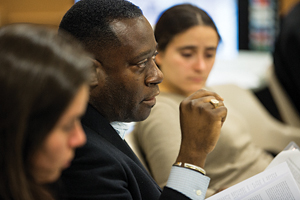
Professor Keith Reeves ’88 leads the Inside-Out class. Photos by Laurence Kesterson
There are two Keiths sitting in a circle in this bare-bones cafeteria—a stark setting for a Swarthmore class. One, Keith W., is 25, compact, handsome, with a goatee. He wears an orange polo shirt and a big grin as he talks about his baby son and how he wants to change his path—his future, his son’s future. He’s been “in” since September, having been nabbed for drug possession, and hopes to make his way back “out” in February.
The other, Keith R., clean-shaven, a couple decades older, has also been thinking about his child—a junior in the Wallingford-Swarthmore School District who is in the beginning stages of the college selection process. Most likely she’ll choose an Ivy-level institution on the West Coast. So here they sit, two smart, attractive men concerned about their children. They’ve arrived in this room, where guards peer occasionally through the lone window, via different paths, yet here, in this circle, they are equals. The older man, “Mr. Keith” to the younger one, can leave this jail—a Philadelphia Prison System work-release site for low-level drug offenders near the University of Pennsylvania—at any time to return to Swarthmore, where he lives and teaches. Keith W. can only leave to work in the daytime or attend a job-training class. At night, he’s locked up.
They’ve spent 14 weeks together this fall semester, these two Keiths, in a circle that has included between seven and a dozen “insiders” (numbers fluctuated as some incarcerated men gained early release, while others lost the privilege to attend due to misconduct), and 13 Swarthmore political-science student “outsiders.”
It’s been a time of awakening for Keith W.—who’d never read a novel till tackling Walter Mosley’s Always Outnumbered, Always Outgunned for The Politics of Punishment class, designed by his like-named circle mate. “Now I read all the time,” he says.
Will Keith W. fulfill his vow “to be a better person when I leave here”? After all, he says, “I give the class a lot of credit for changing my life around. Before, I thought I would go out and do something again and just not get caught. Now I’m going to be oriented toward work, family, school.”
Will the way he feels this December night stick with him?
Keith W.’s fellow students will never know the outcome.
All classes have rules, but this class has especially rigid ones. The Swarthmore students and the inside students are only known by their first names, are not to exchange contact information, or be in touch after the course ends. Breaking the rules brings stiff penalties: failure for the Swarthmore students, punishment for the insiders.
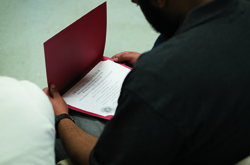
An inside student admires his class certificate at the closing ceremony.
Keith Reeves ’88, associate professor of political science, first taught the course in spring 2012 through the auspices of the Inside-Out Prison Exchange Program, pioneered by Lori Pompa at Temple University in 1997. Inside-Out now has 464 instructors in 38 states and five countries. More than 15,000 inside and outside students have come together to study prisons, from the outside in.
With Reeves’ third class in full swing this spring at the State Correctional Institution in Chester, Pa., the site of his inaugural class two years ago, more than 40 Swarthmore students have had the transformational opportunity that Inside-Out classes often afford.
Chester is familiar turf for Reeves. He grew up there with his late brother Ken ’88—twin sons of a single mother. Thanks to many male mentors—including the Boy Scout master who led meetings at Calvary Baptist Church—the brothers prospered and wound up at Swarthmore. Martin Luther King Jr. taught Sunday school and occasionally preached at that church in the late 1940s, while attending nearby Crozer Seminary. The church is 1.8 miles from the prison that opened in 1998 as the state’s first facility to treat incarcerated men with substance-abuse problems.
This razor-wire–enclosed structure next to Harrah’s casino is where Reeves brings his students to meet real representatives of the penal system—not only the incarcerated men who are their fellow students but guards, the superintendent, other correctional staff, and judges. Swarthmoreans study in real time the systems and the consequences of the mass-incarceration epidemic. There are more than 2.2 million persons incarcerated in local jails or in the custody of state or federal prisons, according to Bureau of Justice statistics. And there are more than 4 million people on probation or parole.
The polarity of the worlds—the inside vs. outside—becomes clear within a few minutes of leaving the College campus. Hana Lehmann ’13, who drove the van for Swarthmore students and teacher Reeves for the three-hour, once-a-week class at the Chester prison in spring 2012, recalls that short trip between two worlds.
“I’d see the change in the scenery; things were starting to crumble,” she recalls. “There were dilapidated buildings with peeling paint—and no more fancy cars. Then there were the racial differences.”
David Kennedy ’80, H’11, a noted criminologist who directs the Center for Crime Prevention at the John Jay College of Criminal Justice, also rode in that van to Chester two springs ago to participate in a class discussion.
“Chester is 3 miles away from Swarthmore, and for all practical purposes, it is in another universe,” Kennedy says. “You look at places like Chester—the effects of racism, bad schools, the root causes of crime. You learn that one of the root causes is that people there don’t trust or expect any help from the police. If somebody’s robbed you, or killed your friend, you don’t call the police—you take care of things yourself and wind up in prison. One thing we want students to walk out understanding is that these communities that we think of as bad communities really aren’t—a few people in them are dangerous, but even most of them feel more trapped and lost than predatory.
“People don’t do what they do because of cold-blooded, ruthless, rational economic calculations,” he adds. “Swarthmore students don’t wonder if life would be better if they became a big-time drug dealer rather than get an education. Swarthmore students grow up in families and a community where going to college is what people do.” Sharing a classroom with Swarthmore students introduces inmates, says Kennedy, “to other possibilities and to people who care about and respect them and who model that there are other alternatives.” And it introduces students to inmates who—while they might have done terrible things—“are transparently not the terrible people the caricatures would have them be.”
While he hopes the course will inspire a seismic shift in the lives of inside students—as Keith W. in Philadelphia contends has happened to him—Kennedy realizes the magnitude of the problem.
“Big changes have to come from another direction, but every little bit helps,” he says. “Every single year the U.S. releases about 700,000 people from prison. There is no way we can fix this problem by coming in afterward and working with these folks. The big changes will come from not locking them up in the first place, but now we have this situation, and we have to do the best with it.”
Kennedy believes “the most important element of what Keith [Reeves] is doing is introducing wonderful, wonderful students with good morals and consciousness to what is going on in front of their faces. It shows people who don’t have the first clue about what is really going on in their neighborhood, their world, their America. When I was at Swarthmore, I was obsessed with apartheid in South Africa and didn’t give Chester a second thought. I’m ashamed of myself, now. This helps fix that, which is fantastically important.”
Although he was a Chester boy, Reeves knew little about the prison that cropped up in his hometown 16 years ago, the year before he came to teach at Swarthmore.
“When I left Harvard to come here, friends kept saying I needed to broaden the story a bit [in a book he was writing on felon disenfranchisement]—that I needed to go down to the prison,” says Reeves.
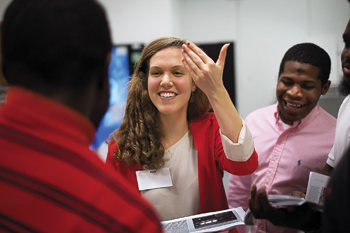
Carmen Smith-Estrada ’14 greets an inside member of her class.
When he learned that a former neighbor was serving a life term at the State Correctional Institution in Chester, “I started visiting him, then working in the space mentoring guys and teaching them decision-making skills.” Reeves taught at a county prison, then “realized I needed to write a broader story about the interplay between poverty and incarceration and what it was doing to this community space that I happened to grow up in and that is emblematic of lots of other community spaces across the country.”
Three years ago, Reeves took the 60 intensive hours of training to become an Inside-Out instructor and developed the Politics of Punishment course, feeling he needed this experience to “confidently tell what I hope will be a newer and broader story that helps us understand why so many black men go off to prison.” Reeves expects the book, whose working title is The Declining Significance of Black Males?: Incarceration, the Inner City, and Public Policy, will be published in late 2015 or early 2016. “It’ll be a pretty controversial book, because it has some pretty hard-hitting policy recommendations,” he says.
While working on the book, he’s also fine-tuning his Chester-based course this spring, with the help of Aya Ibrahim ’15, who took the fall class in Philadelphia and now is his teaching assistant. Reeves, who taught the first class in spring 2012 with Tom Elverson ’75 and Karlene Burrell-McRae, assistant dean and director of the Black Cultural Center, felt a female perspective was missing in the fall class.
While Ibrahim’s interest in public policy was one reason Reeves chose her, one look at her neatly arranged binder of class materials clarifies another. Easily sidetracked, he appreciates her organizational skills.
“We meet before each class and lay out the things we will cover and organize the schedule with assignments,” Ibrahim explains. “I’ll help lead discussions and give a perspective as a student who has taken the course already. But this course is different, because it’s a prison setting and is more intense.” Some of the incarcerated men are lifers, whereas the Philadelphia inside students were “very transient,” she says. “In Chester, they have all the time in the world to do the readings and are very much in the thick of it. The work-release students were on their way out. I’m really excited to see how the classes differ,” she says.
From her experience in Philadelphia this fall, she’s made some realizations—the kind that David Kennedy had hoped the experience would prompt. “We’re taught to have an image of how a criminal should be, yet I met some of the kindest people in the class,” Ibrahim says. “Some are bending over backward to improve their situations. They’ve become aware of how systemic the problem is and realize there are much greater forces at play, making it more likely for them to go in one direction rather than another.”
One of the course’s seminal texts, The New Jim Crow, helped aspiring inner-city teacher David Zhou ’15 understand “how mass incarceration affects a community. [Author] Michelle Alexander says positive role models might help, but there are other factors. I asked the inside students if a teacher had tried harder, would they have committed a crime? Would that have changed their outcome? It was sobering to hear some of the inside classmates say that even if a teacher had gone above and beyond, it wouldn’t have helped. Some of them did say it might have made a difference, but for me, as someone who wants to be a teacher, that was discouraging.”
It was further troubling, says Zhou, when “one guy said a lot of the reason people deal drugs is they need money for their families. He said after he gets out, he’ll try to get a job but will go back to selling drugs. It showed me how entrenched these things are. It’s sobering to think that even learning about the systematic oppression and injustices, it hasn’t changed his reality. … I hope things work out for him and will keep him in my prayers.”
The course, however, altered Zhou’s reality. “The life lessons I learned changed something about the way I see the world.”
Lehmann, the van driver for Reeves’ first course, was similarly affected. “Everyone who had this class was changed in some way,” she says. How that transformation occurred was the topic of her 150-page senior thesis, which won the award for best political-science thesis of 2013. “In this course, a person starts with a particular understanding of things, but the space the course creates breaks something,” she explains. “There is a change, and you end up in a different place. Students come out with more freedom to make sense of the world.”
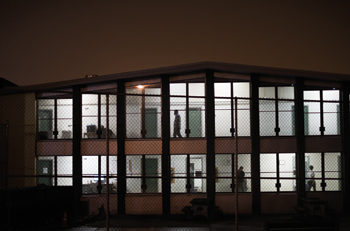
Incarcerated men at the Philadelphia Prison System work-release site have the opportunity to take college classes through the Inside-Out Prison Exchange Program.
Daughter of a Filipino mother and German/Irish father, Lehmann lived for 10 years on a Lakota Sioux reservation in South Dakota, where her father was a physician. “In South Dakota, the image of a criminal is a meth abuser,” she says. “South Dakota is very white. I didn’t understand the racial dynamic [before taking the course in Chester].”
As a result of taking the Politics of Punishment course, says Lehmann, “most outside students do something related to incarceration, according to their gifts.” Her gift, besides writing her thesis, was taking the Inside-Out training this winter—the same training that Reeves took—which now qualifies her to facilitate a class. She hopes someday to help Swarthmore expand the program Reeves began. He shares that aspiration, citing interest from students and faculty from other disciplines.
“Now that we know that the model and the process work, we’ll have a conversation about how to grow capacity and possibly add another course,” he says. “We have more demand to take the course than we can meet, which is always a good problem to have.”
While most students, like Lehmann, Zhou, and Ibrahim, were not acquainted with the criminal-justice system before the course, a few, like Steve McFarland ’15, have been all too close to it.
“Growing up in Philadelphia with a lot of cousins who had been to jail, I always had a personal stake in it, and I knew where they [the Philadelphia inside students] came from,” says McFarland. “How can we assume a kid living in that neighborhood wouldn’t end up there? There are so many things we can be doing. In Philadelphia, so much time is spent incarcerating rather than educating.”
For his course project, executed with a mix of inside and outside students, McFarland researched one program that could help—the Work Opportunity Tax Credit—given to businesses that hire the recently incarcerated. “There is money in the pot, but businesses are just not taking advantage of one of [Philadelphia] Mayor Nutter’s bright ideas,” McFarland says.
Another of the four projects involved designing a business plan for a franchise of Green Demolitions, a Greenwich, Conn.-based company. Its employees remove kitchen and bathroom components from the homes of affluent people who are remodeling and make them available at steeply discounted prices to middle-class renovators. Reeves stipulated that the students include in their business plan training and hiring of individuals recently released from jail or prison.
He tasked the third group with depicting what a new civil-rights movement would look like, particularly one incorporating social media tools. As part of their charge, the students promoted a day in February to advocate against plea bargaining. The fourth group developed a resource guide to help the newly released connect with their parole officers, acquire a drivers license, a GED, and other life skills.
All the projects fulfill what Lehmann says is Inside-Out founder Pompa’s requirement—that “all projects have legs in the world that make them substantial.”
While Reeves’ class follows the framework set by Pompa, there are a couple of differences.
“A lot of classes have three or four correction facility staff sit in. I operate under a rhetoric of political incorrectness,” he says. “They function like one of my regular Swarthmore classes”—meaning there is no supervision. Another important distinction occurs on the final night of class, when Reeves leads a closing ceremony. He invites the warden (at the work-release site) or the superintendent (at Chester) and judges to hand out certificates of course participation to the inside and outside students.
“No other course in the country gives a certificate meant to look like a Swarthmore College diploma,” says Reeves. “It’s meant to be a credential, an opportunity, that I hope they [inside students] can bring to a judge, employer, or a parole officer.”
While Reeves wants the students to part with something tangible from their shared experience, his own takeaway is internal.
“This is a personal journey but also a professional journey—to understand how this community space [in Chester, in particular], which helped give rise to someone like King, has all of these men with criminal backgrounds coming out of prison not able to legitimately fuel the labor market. It’s fueling the intergenerational poverty that we’re seeing among inner-city communities. This course is a nice space to grapple with some of those issues.”
Listen to David Kennedy’s recent campus talk “From Swarthmore to the Streets” here.
Watch a video about Keith Reeves ’88 and his course by Christina Abellan-Matamoros ’14 here.
 Email This Page
Email This Page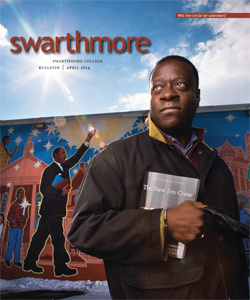
April 25th, 2014 8:51 pm
This is Swarthmore at its best—challenging, changing, engaging, hoping, planning, executing. Thanks to Sherri Kimmel for a brilliant article.